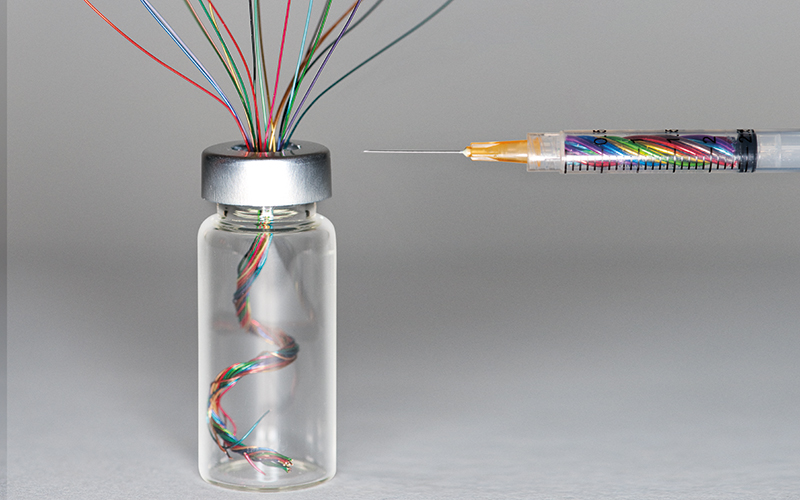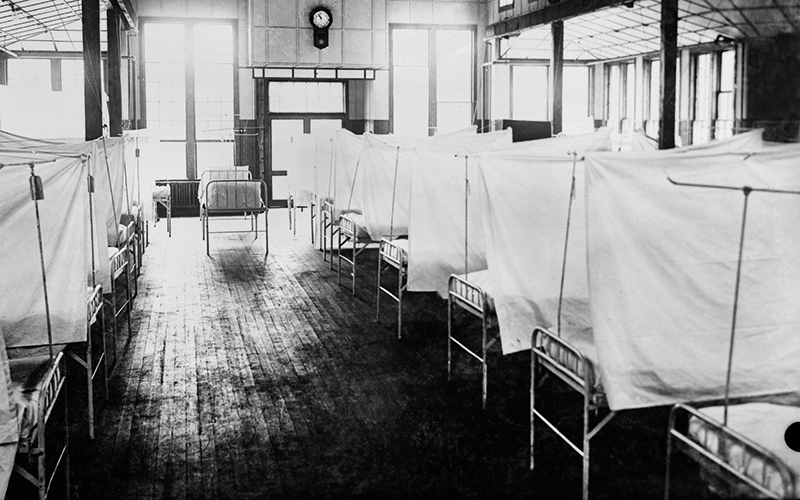Scientists in Pennsylvania have developed an mRNA vaccine for flu that could serve as a “general preventative measure against future flu pandemics”.

Prior to the emergence of COVID-19, research to validate and optimise the use of mRNA as an effective platform for infectious disease vaccines was ongoing into Zika, rabies and other viruses. The technology, which used mRNA delivered in lipid nanoparticles (LNP), was also being developed for anti-cancer drugs.
But the success of the COVID-19 mRNA LNP vaccines provided an impetus for further research, which has led to the development of an experimental vaccine against all 20 known subtypes of the influenza virus. Tests on animal models showed that the multivalent vaccine dramatically reduced signs of illness in the animals and protected from death, even when exposed to flu strains different from those used in making the vaccine.
The US researchers vaccinated mice and ferrets using immunogens from all known influenza subtypes. When the vaccine was taken up by recipient cells it started producing copies of the haemagglutinin (HA) protein for all 20 influenza HA subtypes – H1 through to H18 for influenza A viruses, and two more for influenza B viruses.
In mice, the mRNA vaccine elicited high levels of antibodies, which stayed elevated for at least four months, and reacted strongly to all 20 flu subtypes. The vaccine also seemed relatively unaffected by prior influenza virus exposures – the antibody response in the mice was strong and broad whether or not the animals had been exposed to flu virus before.
Divergent strains
“The aim of this type of vaccine was not to completely prevent infection by all the viral subtypes (sterilising immunity) but instead to elicit memory immune responses against a broad range of influenza strains,” says Dr Ying Tam, Chief Scientific Officer at Acuitas Therapeutics, and study co-author. “Then, when exposed to a new viral strain, these memory immune cells would be recalled to rapidly respond and adapt.”
The baseline level of immune memory to diverse flu strains acts to reduce the incidences of severe disease and death, even against newly emergent pandemic strains. “A related phenomenon has previously been described where influenza infection can provide protection against severe disease from other influenza viruses bearing a related HA protein and is also similar to the situation with the first-generation COVID-19 vaccines, which did not prevent infection by newer strains but did provide protection against severe disease.”
Dr Seema Lakdawala, Associate Professor, Department of Microbiology and Immunology, at the University of Pittsburgh School of Medicine, and study co-author, says: “I personally was surprised at how well the vaccine produced antibodies against all components almost to equivalent levels in both mice and ferrets.”
The vaccine included 18 different flu A HA sequences from varying animal hosts including birds, seals and bats, that are distinct from what has been successful in the human population to date. But the sequences do pose emerging pandemic risks. “The research demonstrated that we can expand beyond four distinct vaccine components and get protection against divergent strains that will reduce severity of disease.” Seema adds. “For example, in ferrets the vaccine protected against a bird H1N1 virus, which was distinct from the H1N1 that was a component of the vaccine.”
Surprisingly few obstacles emerged during the research, including supply chain difficulties during the pandemic. But one potential challenge is the need to “develop appropriate analytical techniques to adequately characterise the quality of the high-valency mRNA LNP vaccines”, Ying Tam says.
Very encouraging results
The goal of a universal flu vaccine is to elicit long-lasting adaptive immune responses that are broadly cross-reactive against any strain of the influenza virus that can infect humans and provide protection against infection and severe disease, Ying Tam points out.
“Previous efforts to develop universal influenza vaccines used a much more limited number of antigens, focusing on including antigens in the vaccine that were conserved (that is, were similar or identical) across a range of different influenza virus subtypes,” he adds. “In that way, inducing an immune response against the conserved antigen should result in reactivity and protection against a broad range of flu viruses.”
Ying cites the example of vaccines that induce immune responses to the “stalk” portion of the HA antigen. Existing flu vaccines are very effective at eliciting antibody responses against the immunodominant “head” portion of HA, which is prone to changes or mutations, allowing new viral strains to emerge that can evade existing immunity. “The ‘stalk’ portion is much less likely to change and is consistent in HAs from different influenza strains,” he adds. A vaccine incorporating a single or small number of HA antigen(s) designed to elicit “stalk” specific immunity could protect against a wide range of influenza strains.
“It’s very easy to stretch the conclusions and we must not do that”

Dr Christopher Ring, Visiting Lecturer in Infectious Diseases at a number of universities in and around London, points out that the current flu vaccines are far from ideal. “They are targeted to a limited number of strains – in effect just four – which we predict are the ones that are likely to be circulating within the following season,” he adds. “The researchers were very careful not to push the word ‘universal’ in the title. It’s very easy to stretch the conclusions and we must be careful not to do that, but the results are very encouraging.”
“The researchers only tested for protection following challenge with just one subtype of influenza – the H1 subtype. We’ve also had pandemic viruses that are H2, H3, and we have had quite a few other subtypes in avian species. So we really do need to test those subtypes as well,” he adds.
Dr Sarah Pitt, Principal Lecturer, School of Applied Sciences, at the University of Brighton, adds that the research is “potentially very exciting”. “What they are saying is they can combine sequences or the known main strains of flu A and flu B,” she says. “That means they wouldn’t have to keep developing a new flu vaccine every year.” But she adds the caveat that if immunity to flu wanes, as it does with coronavirus, we would still need boosters.
Groundbreaking therapeutic technology
In 2005, after working together for seven years, two scientists found that if one of the four nucleosides in messenger RNA (mRNA) was altered, the single-stranded molecule could be delivered effectively into the body to initiate an immune response.
In their groundbreaking research, Dr Drew Weissman, Roberts Family Professor in Vaccine Research and Dr Katalin Karikó, an Adjunct Professor of Neurosurgery, found that a variety of natural RNAs had different capacities to activate immune cells.
By modifying mRNA, which has the job of carrying protein information from the DNA in a cell’s nucleus to cytoplasm, they could “turn cells into factories that can temporarily produce proteins that serve as therapeutic compounds or stimulate the body’s immune response to a specific pathogen”.
Vaccines produced with mRNA technology have been proven safe and effective following the pandemic, with both Pfizer/BioNTech and Moderna licensing the University of Pennsylvania’s technology for a vaccine against COVID-19. The technology can be reengineered quickly to take on emerging pathogens and new variants.
So significant has their work been that Weissman and Karikó were awarded the 2021 Lasker-DeBakey Clinical Medical Research Award – considered the US’ top biomedical research prize.
Drew Weissman and his laboratory collaborated with Dr Scott Hensley, a Professor of Microbiology at the Perelman School of Medicine, and his lab on the research into influenza.
Future pandemics

Predicting the next pandemic is “frankly a mug’s game”, Sarah Pitt says. “We have to be prepared for all eventualities, but we can’t necessarily predict what it is going to be and when.”
She points out that the 2009 pandemic influenza was not bird flu from South East Asia as everyone was predicting. The virus had combinations of different animal influenza types within it. “Pandemic flu is fascinating. All you need is a single cell in a person’s body that has been infected with a human version of flu and an animal version of flu at the same time. They recombine in that cell and take off inside that one person. The chances of that happening are minuscule.”
Sarah adds: “You’d hope that COVID-19 would be a wake-up call but I do feel to some extent that people have the view that we got away with it.”
Christopher Ring thinks that the next pandemic will likely be a coronavirus or influenza, perhaps from an animal or bird. “We need to continue to work on other strategies in an attempt to develop a universal flu vaccine,” he says. “We need vaccines which are more reliable [than those we have] in protecting us from whatever will be circulating in the future.”
“It’s clear that mRNA is relatively easy to design and to manufacture”
“It’s clear that mRNA is relatively easy to design and to manufacture,” he adds. “I don’t see why you couldn’t at least think in theory about extending the strategy to cover SARS-like viruses, or indeed coronaviruses in general.”
The research teams are currently designing human clinical trials with the vision that if they are successful, the vaccine may be useful for eliciting long-term immune memory against all influenza subtypes in people of all age groups, including children.
“While I expect the results to be largely replicated in humans, there is the possibility that responses in humans may diverge from those seen in this work,” Ying Tam says. “The likelihood of positive data in humans is supported by available clinical data for mRNA LNP vaccines including positive data for single and bivalent vaccine formats.”
Seema Lakdawala adds that prior immunity to influenza infections in adults could have an impact on responses to the vaccine in future human trials. “The promising animal results and safety of mRNA vaccines give me confidence that it is worth doing,” she concludes.
Timeline: Developing a flu vaccine

1918 Researchers in Europe and the US produced thousands of doses of vaccine in an effort to find an effective inoculation against the influenza A virus subtype H1N1 during the pandemic. Unfortunately, they were targeting a bacterium we now know as Haemophilus influenzae, rather than the true pathogen.
1933 British virologists W Smith, CH Andrewes and PP Laidlaw isolated and identified the influenza virus in ferrets at the National Institute for Medical Research in London. Finding no bacteria in throat washings from patients with influenza, they realised the disease was cause by a virus, not bacteria.
The blood of some influenza patients did not develop antibodies to the strain, leading researchers to suspect that different types of influenza viruses existed. During this period, researchers also discovered the existence of another strain – influenza B.
1936 Australian virologist Macfarlane Burnet discovered that the flu virus could be grown in embryonated hens’ eggs, resulting in the development and use of inactivated vaccines.
1942 A bivalent vaccine was developed that protected against the H1N1 strain of influenza A and influenza B.
1945 The first inactivated flu vaccine, developed by US virologists Thomas Francis and Jonas Salk, was licensed for wider use, after being tested for safety and efficacy on the US military.
1947 Researchers discovered that existing vaccines were ineffective against the flu viruses circulating at the time.
1948 The World Health Organization established the Worldwide Influenza Centre to investigate the viruses in circulation.
1952 The WHO set up the Global Influenza Surveillance and Response System, comprising 124 institutions, which ensures preparedness and response for seasonal, pandemic and zoonotic influenza.
1957 A pandemic of influenza A subtype H2N2 resulted in 1–4 million deaths.
1968 Another pandemic, this time of influenza A subtype H3N2, also led to a total of up to 4 million deaths around the world.

2003 A live attenuated nasal spray vaccine was licensed for the first time.
2012 Cell cultures emerged as an alternative method to hens’ eggs to producing influenza vaccines.
2013 A non-live vaccine using recombinant DNA technology was licensed for the first time.
Sources: Centers for Disease Control and Prevention, World Health Organization
Image credit | Richard-Gleed |Getty | Science-Photo-Library




